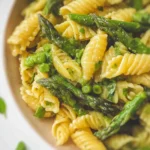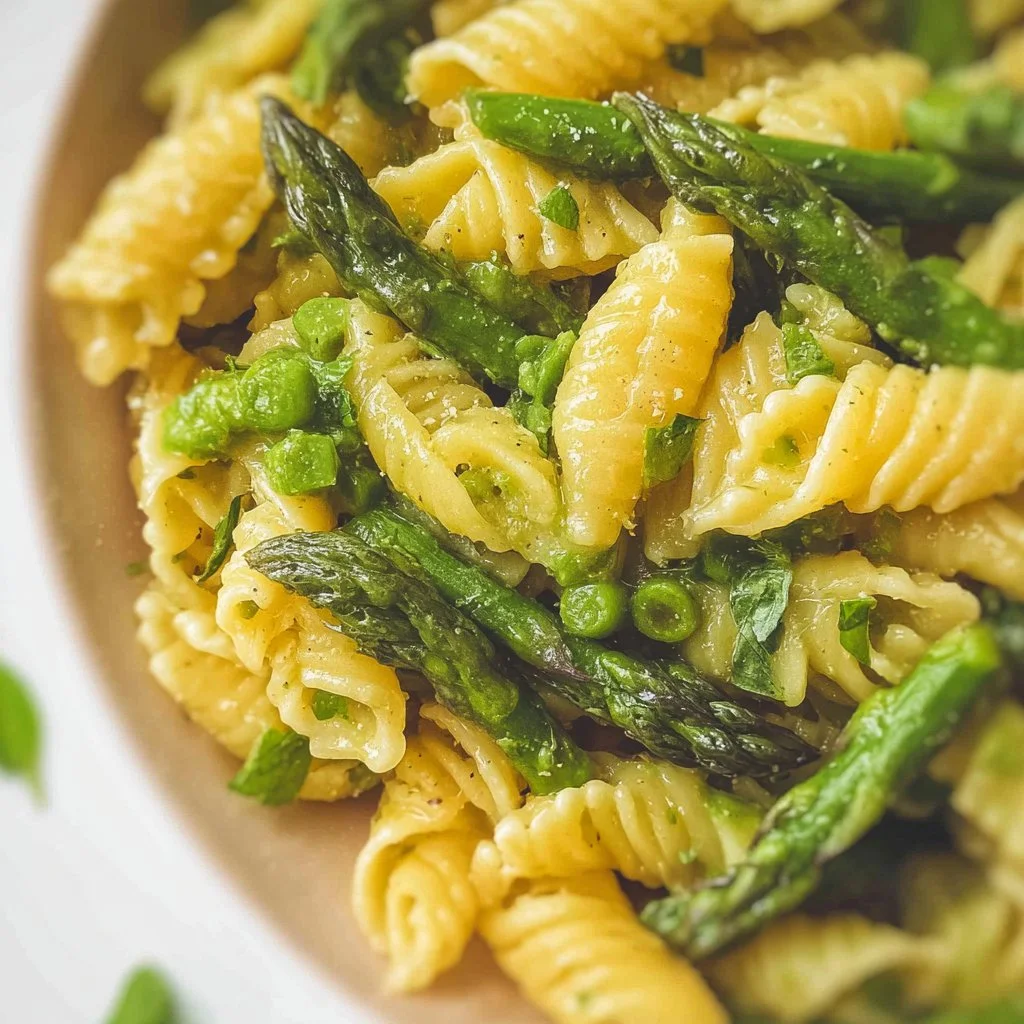Asparagus Pasta is a simple, fresh, and flavorful meal that’s perfect for spring or any time you crave something light yet satisfying. With tender asparagus, garlic, and a splash of olive oil, this easy pasta dish comes together quickly and highlights the beauty of fresh ingredients.
Why We Love This Asparagus Pasta Recipe
What sets this asparagus pasta apart? It’s about the balance of flavors and the straightforward preparation. The freshness of the asparagus combined with the aromatic garlic creates a wonderful foundation for this dish. Plus, the added richness of Parmesan cheese makes it a crowd-pleaser.
This recipe is flexible and adaptable. Whether you prefer a touch of brightness with fresh basil or a hint of earthiness with thyme, you can customize it to suit your taste. It is also vegetarian-friendly, making it accessible for various dietary preferences. Not to mention, it’s a great way to sneak some veggies into your meal, especially for those who are not big fans of greens.
Ingredients for Asparagus Pasta
To make your delicious asparagus pasta, gather the following ingredients:
- 12 ounces pasta (any shape)
- 2 tablespoons extra virgin olive oil
- 1 small onion, finely chopped
- 3 cloves garlic, grated
- 1.5 pounds asparagus (fresh or frozen)
- 3/4 teaspoon salt (or more to taste)
- 1/8 teaspoon black pepper
- 1/2 cup grated Parmesan (or more to taste)
- 1/2 cup fresh basil (or 3 sprigs fresh thyme)
- 1/2 lemon, juice and zest
These ingredients not only bring the dish to life but also provide a delightful nutritional profile. Asparagus is packed with vitamins and provides a satisfying crunch, while the olive oil adds a touch of heart-healthy fats.
How to Make Asparagus Pasta
Creating asparagus pasta is a straightforward process that yields amazing results. Here’s how to do it:
Start by preparing the asparagus. Cut off and discard the woody end, which is about one inch. Next, cut the spears into discs, remembering to leave the tips whole for visual appeal.
In a large skillet, heat the extra virgin olive oil over medium heat. Add the finely chopped onion and sauté for about three minutes or until they soften and become translucent.
Now it’s time to bring in the asparagus! Add the chopped asparagus, grated garlic, salt, and black pepper to the skillet. Stir everything together and cook for around five minutes until the asparagus is bright green and fork-tender. You may add a small splash of water after one minute to help steam the asparagus and enhance the cooking process.
To create a creamy sauce, transfer half of the sautéed asparagus into a food processor. Add in the fresh basil, grated Parmesan, and lemon juice along with two tablespoons of water. Blend these ingredients until your mixture is creamy and smooth.
Meanwhile, cook your pasta in a big pot of salted boiling water according to the package instructions. Timing is key here, so keep an eye on the pasta while it cooks!
Once the pasta reaches your desired level of tenderness, reserve about half a cup of the starchy pasta water. Drain the pasta and add it directly to the skillet with the remaining asparagus. Pour the creamy sauce over the top, then include the reserved pasta water gradually, stirring until the dish comes together in a harmonious, creamy blend.
Before serving, taste the pasta and adjust the salt if necessary. To enhance it further, give it a drizzle of olive oil and some added zest from the lemon.
Your asparagus pasta is now ready to be enjoyed! The fragrant aromas emerging from your kitchen will have everyone eager to sit down and share this delicious meal.
How to Serve Asparagus Pasta
Serving asparagus pasta is as simple as it is enjoyable. You can serve this dish in large, family-style bowls, allowing everyone to help themselves. Alternatively, for a more formal occasion, plate individual servings and garnish with a sprinkle of Parmesan and additional herbs for a touch of elegance.
Pair this vibrant dish with a side salad or some crusty bread for a complete meal. A simple arugula salad dressed with lemon vinaigrette complements the flavors beautifully. Remember, the star of the show is the asparagus pasta, so let its fresh flavors shine through without overwhelming it with too many side dishes.
Expert Tips for Asparagus Pasta
To ensure your asparagus pasta turns out perfectly every time, here are some expert tips to consider:
- Use fresh asparagus if you can find it. It generally has a better flavor than frozen, although the latter can still work well in a pinch.
- Don’t overcrowd the skillet when sautéing the onion and asparagus. If your skillet is too small, consider sautéing in batches to maintain proper heat and browning.
- For an extra punch of flavor, feel free to add a bit of crushed red pepper flakes during cooking. This addition provides a delightful kick without overpowering the dish’s overall balance.
- Adjust your pasta cooking time according to the pasta shape. For instance, larger shapes like fettuccine may take longer than smaller varieties like penne.
These tips can help you achieve a delicious asparagus pasta that impresses.
How to Store Asparagus Pasta
If you’re fortunate enough to have leftovers or want to prepare ahead, storing asparagus pasta is simple:
- Allow the pasta to cool to room temperature before transferring it to an airtight container. This helps prevent sogginess.
- Store it in the refrigerator, where it will keep for up to three days. When you’re ready to enjoy it again, simply reheat in a skillet over low heat, adding a splash of water or olive oil to prevent sticking.
For longer storage, consider freezing the asparagus pasta. However, be aware that freezing might affect the texture of the asparagus slightly. Make sure to seal it tightly in freezer-safe containers or bags to avoid freezer burn.
Variations of Asparagus Pasta
One of the great things about asparagus pasta is its versatility. Here are some variations you can try:
- Add Protein: If you want to make the dish heartier, consider adding grilled chicken, sautéed shrimp, or even chickpeas for a plant-based protein.
- Experiment with Cheese: While Parmesan is fantastic, try substituting Pecorino Romano or a blend of your favorite cheeses for a different flavor profile.
- Incorporate Other Vegetables: Feel free to mix in other seasonal vegetables like peas, cherry tomatoes, or spinach. This not only adds more nutrients but also creates a more colorful dish.
- Change the Herbs: Swap out basil for fresh parsley or dill. Each herb brings its unique flavor, giving an exciting twist to this classic dish.
These variations make it easy to adapt your asparagus pasta to suit any occasion or preference.
FAQ: Asparagus Pasta
What is asparagus pasta?
Asparagus pasta is a dish where pasta is combined with asparagus, garlic, and other flavorful ingredients. It’s a vibrant and nutritious meal that can be prepared quickly.
Can I use frozen asparagus for this recipe?
Absolutely! Frozen asparagus works well and is convenient. Just be sure to thaw it properly and adjust cooking times accordingly.
How can I make asparagus pasta gluten-free?
You can easily make this dish gluten-free by using gluten-free pasta made from rice, quinoa, or lentils.
What other seasonings can I add to asparagus pasta?
In addition to salt and pepper, consider adding lemon zest, crushed red pepper flakes, or herbs like thyme and oregano for extra flavor.
Can I make asparagus pasta ahead of time?
Yes, you can prepare the components ahead of time and assemble them just before serving, or store leftovers in the refrigerator.

Asparagus Pasta
Ingredients
Pasta and Asparagus
- 12 ounces pasta (any shape)
- 1.5 pounds asparagus (fresh or frozen) Cut off woody ends and cut into discs, tips kept whole.
Flavor Base
- 2 tablespoons extra virgin olive oil For sautéing.
- 1 small onion, finely chopped To add sweetness.
- 3 cloves garlic, grated For aromatic flavor.
Seasoning and Garnish
- 3/4 teaspoon salt Adjust to taste.
- 1/8 teaspoon black pepper
- 1/2 cup grated Parmesan Or more to taste.
- 1/2 cup fresh basil Or 3 sprigs fresh thyme.
- 1/2 lemon juice and zest
Instructions
Preparation
- Cut off and discard the woody end of the asparagus, about one inch, and cut the spears into discs.
- Heat the extra virgin olive oil in a large skillet over medium heat.
- Add the finely chopped onion and sauté for about three minutes until softened and translucent.
Cooking
- Add the chopped asparagus, grated garlic, salt, and black pepper to the skillet.
- Cook for around five minutes until the asparagus is bright green and fork-tender. Optional: add a splash of water after one minute.
- Transfer half of the sautéed asparagus to a food processor, add fresh basil, grated Parmesan, and lemon juice with two tablespoons of water, then blend until creamy.
- Cook the pasta in a large pot of salted boiling water according to package instructions.
- Reserve about half a cup of the starchy pasta water, drain the pasta, and add it to the skillet with the remaining asparagus.
- Pour the creamy sauce over the pasta, and gradually stir in the reserved pasta water until creamy.
Serving
- Taste and adjust salt if necessary, then drizzle with olive oil and lemon zest.
- Serve in large bowls or plate individual servings garnished with Parmesan and herbs.
Send me this recipe!
Just enter your email below and get it sent straight to your inbox!



